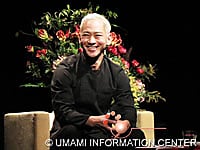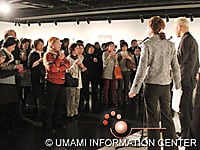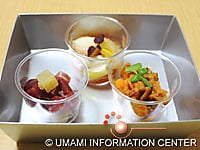[Lecture report] Bound in Umami - Spanish and Japanese Cuisines
March 2014
Umami Information Center (UIC) held the Japan-Spain Relationship 400th Anniversary Commemoration Gastronomy Seminar "Spanish Cuisine and Japanese Cuisine Connected with Umami" in collaboration with the Instituto Cervantes Tokio (established by the Spanish government in 1991) at 1pm on Monday, February 17.
2013 marked the 400th anniversary of the Keicho-era mission to Europe, with which Lord Masamune Date of Sendai Domain dispatched Tsunenaga Hasekura as an ambassador to Philip III of Spain between 1613 and 1620. They are hosting commemorative events with art, music, and traditional performing arts, etc. in Japan and Spain both for 1 year between June of last year to July of this year.
In addition, the Spanish cuisine industry has been leading the recent gastronomy industry, affecting the cooking industry not only in Europe but also in North America, South America, and Asia. On the other hand, Japanese cuisine has been attracting attention from Europe and the U.S. as healthy cuisine that maximizes the flavors of ingredients by making a good use of dashi and umami. Top chefs throughout the world have especially been focusing on umami. Furthermore, "Washoku, traditional dietary cultures of the Japanese" was designated as an intangible cultural heritage asset by UNESCO last December and is expected to attract more attention from the world.
Using this opportunity, UIC planned and held an umami seminar, which was coordinated by Scientific Affairs Representative Ana San Gabriel (from Barcelona, Spain) of UIC. UIC invited Mr. Chikara Yamada as the lecturer. Mr. Yamada trained in Japan and Spain both for cooking and is now the owner-chef of "Yamada Chikara" in Azabu, attracting attention with his original creative cuisine.
Following the opening speech by Ms. Teresa Iniesta, who is the Gestora Cultural (Cultural Manager) at Instituto Cervantes Tokio, Section 1 held an interview session in which Ana San Gabriel (from Barcelona, Spain) asked questions and Mr. Yamada answered them with stories of his personal experience in Spain.
Q. Why did you choose chef as your career?
A. It started when I worked with French cuisine in a hotel in Atami after graduating from high school, wanting to create something or use my body to work.
Q. Why did you choose Spain as your training location?
A. I had wanted to work overseas someday, but it's not that I particularly had Spain in mind. My father was an architect, so I had been surrounded by photo collections and art books of Spanish artists, such as Gaudi, Miro, and Picasso, etc., since I was little. I naturally selected Spain.
Q. How did you meet Ferran Adria?
A. When I was 28 and working at a restaurant in Roppongi during my temporary return to Japan, Mr. Adria visited Japan for a promotion project of the Spanish Embassy. Because they were being closely covered by TV, I accompanied Mr. Adria's group for approximately 1 week as an interpreter and staff who was familiar with food and Spanish. When I told Mr. Adria that I had always wanted to work at "El Bulli," he immediately accepted my request. I went back to Spain as if to follow Mr. Adria.
Q. What did you learn from Mr. Ferran Adria at "El Bulli"?
A. Ferran, who excels at imagination and leadership to skillfully use people, used to always say "Think on your own why you do it. Think, think, and thoroughly think until you find the answer." The bi-weekly technical study sessions were very open and flat. There was no hierarchy between the kitchen staff during these sessions, and Mr. Adria also openly answered questions. 1.5 years at "El Bulli" was a very valuable experience. This experience turned into my desire to have my own restaurant in Japan and led me to come back to Japan.
Q. What are common aspects and different aspects of ingredients and food culture between Spain and Japan?
A. Spain and Japan both have wonderful local ingredients in different areas. I think each area has established its own unique food culture through local production/local consumption in both countries. If I point out one difference, I think it would be the distribution network of ingredients. We can find ingredients from all over the world in Tokyo, but I don't think it's the same way in Madrid. When I was in Spain, I often drank wine from Catalonia, which is where Barcelona is located, but I learned about Spanish wine from other areas after I came back to Tokyo. I think another common aspect between Spanish ingredients and Japanese ingredients is that they both have a lot of ingredients rich with umami. For example, tomatoes, uncured ham, and cheese are rich with glutamate, which is an umami substance, and are often used in Spanish cuisine. In Japanese cuisine, we use kombu, which is rich with glutamate, and dried bonito flakes, which are rich with inosinate, to make dashi. Although we use different ingredients, Spanish cuisine and Japanese cuisine have the common sense of taste called "umami." We can make delicious dishes by understanding umami and skillfully using its functions.
Q. How come you opened a Japanese cuisine restaurant instead of Spanish cuisine after returning to Japan? What is your attachment to Japanese cuisine?
A. Although my dishes don't look like Spanish cuisine, I also use uncured ham, cheese, and olive oil as ingredients. I aim to propose dishes that customers desire and expect and offer a space for meals that enables customers to spend enriching time, which is something I learned in Spain. In addition, I am deeply interested in tea ceremony and chakaiseki (dishes served before tea ceremony) because of my wife's influence. My ideal cuisine is based on simple minimalism, in which I make a full use of the ingredients without adding too many processes.
In addition, Ana San Gabriel, who was the coordinator, explained the basic information of umami, including the representative umami substances glutamate, inosinate, and guanylate, ingredients that are rich with these substances, umami's synergetic effects, and the fact that umami is enhanced through fermentation/aging. Participants deepened their understanding of umami.
In Section 2, we offered an umami experience in the 2F gallery.
Umami experience using cherry tomatoes
Chew on a cherry tomato 30 times while using 5 senses to experience how umami tastes.
Umami experience with dishes specially prepared
by Mr. Chikara Yamada
"Uncured ham and Manchego cheese platter"
(umami ingredients representing Spain)
(At the left of the tasting sample picture)
Spanish-style organ meat stew "Callos"
(At the center of the tasting sample picture)
(combining the umami of organ meat and Japanese dried shiitake mushrooms)
"Calcots: Grilled onions of Catalonia with Romesco sauce"
(Dish with the fusion of Spanish umami and Japanese umami, combining Romesco sauce spiced with garlic, nuts, and paprika with grilled kombujime (preparation technique using kombu) onions)
(At the right of the tasting sample picture)
After the sample tasting, active Q&A was held.
There were questions on Spanish cuisine and ingredients, such as umami in paella and umami of pickled olives, etc., as well as very specialized questions, such as whether or not umami synergetic effects can also be achieved with fragrance in the same manner and whether or not umami feels differently depending on the temperature, etc. Mr. Yamada and Ana San Gabriel both answered these questions in an easy-to-understand manner, deepening the understanding among participants.
At the end of the seminar, a participant commented that he (she) felt that Japanese sake would be more suitable than wine for the samples tried on the day, although they truly were Catalonia dishes. (Mr. Yamada) explained that the dishes probably turned out to be suitable for Japanese sake due to the facts that he cooked them with as little oil as possible because they were going to eat them cold and that he used dried shiitake mushrooms and kombujime to add umami. All of the participants correctly experienced Spanish cuisine and Japanese cuisine connected with umami.
Two hours passed before we knew it, and the closing time came. Participants shared positive comments with us, saying "It was educational" and "The contents were interesting" in response to the fun talks and delicious samples.
UIC will continue to promote these activities to deepen people's understanding of umami and popularize umami. We thank you in advance for your continuous support.




